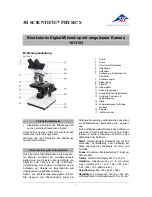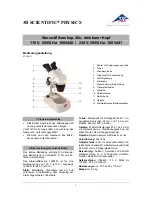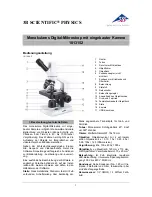
Further Experiments:
Try out the above procedure with other salts such as Epsom
and Rochelle. Sugar will also crystallize, but you will need to let it dry overnight for
the crystals to form.
Preparing a Mount
Dip your spatula in some clean water and make a smear across a clean slide. Use
your tweezers (
A, Fig. 1
) to place a portion of an insect
— a wing, a leg, insect — a
wing, a leg, or an antenna
— on the slide. Attach a cover slip (
G, Fig. 1
) over the
specimen and place the slide on the microscope stage.
Obtain a piece of hair from your head or from your pet and place it on a wet slide.
Try this again with more than one type of hair on a slide and compare how they differ.
Also try a piece of fern (or other plant) and pollen and compare them as well.
Creating Smears
Using your scalpel
(B, Fig. 1),
gently scrape off small shavings from the surface of a
freshly cut potato.
Smear the shavings onto a clean slide
(see Figs. 6 and 7).
Clean the scalpel by
swishing it in the slush water. Draw up some water using your eyedropper from the
cup labeled clean and put one drop onto the slide. Attach a cover slip to the slide
and place to the microscope stage. Observe the slide and write down your
observations. You will see hundreds of starch grains.
Take a few kernels from an uncooked ear of corn. Scrape off some shavings and
make a smear as you did with the potato. Compare how the corn different from
potato. Create smears of other foods such as apples, bananas, peaches, and
pineapples. You will observe that these items have membranes rather than starch.
Fig. 6 Fig. 7
A Simple Section Slide
Section slides are extremely this slices of tissues of skin, leaves, flower stems, and other
materials, generally, section slides are very difficult to make without special equipment and
procedures. However, there is one common house-hold item which can be sectioned without
special equipment: the common onion, made up of layers of tissue.
Peel off the very thinnest layer you can. One that is nearly transparent will make an ideal
section.Slice into a piece about 1/4 x 1/4 inch.
Life Under Glass
Fill a wide mouth jar with fresh water. Let if stand for three or four days without the lid. Then
drop a handful of dry grass and a pinch or two of dirt into the jar. Put the cap on the jar and
P. 8
CAUTION
: The blade of the micro-slicer is very sharp.
Handle the micro-slicer with care.




























